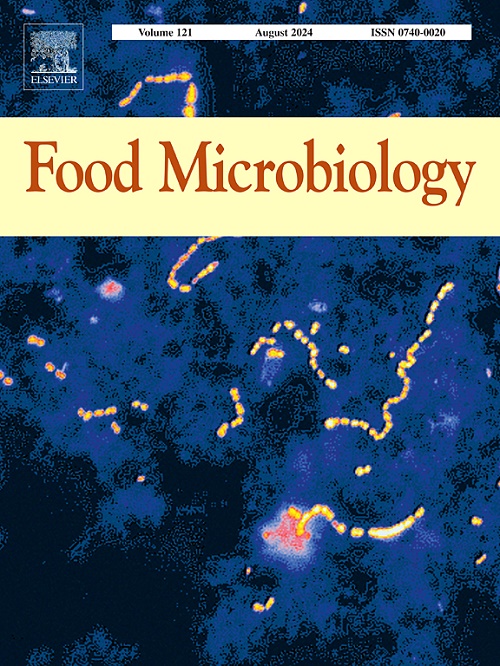环境条件对粪肠球菌在小麦粉与选定接触面之间存活和转移的影响
IF 4.5
1区 农林科学
Q1 BIOTECHNOLOGY & APPLIED MICROBIOLOGY
引用次数: 0
摘要
低水分食品安全问题经常与沙门氏菌及其交叉污染有关。作为非致病性替代物,研究了粪肠球菌NRRL B-2354在不锈钢(SS)和聚丙烯(PP)表面的存活水平和转移情况。在不同温度(13、25、37和49℃)和湿度(45、55、65和75%)条件下,测定了粪肠杆菌在面粉和小麦粉之间的转移率。结果表明,所选择的材料类型对粪肠杆菌的存活率无显著影响。在25°C和45%湿度条件下,接种量为~ 107 CFU/cm2的粪肠杆菌在SS和PP表面分别减少了2.69±0.28 Log CFU/cm2和2.85±0.32 Log CFU/cm2。虽然温度对传输率没有显著影响,但湿度对传输率有显著影响。在75%的相对湿度条件下,玉米粉向小麦粉的转移率最高(5.10±0.23%)。粗糙的表面降低了从面粉到小麦粉的转移率,而不是相反。此外,小麦籽粒向面粉的转移率显著高于小麦籽粒向面粉的转移率。这些发现强调了环境因素和表面性质在交叉污染中的重要作用。本文章由计算机程序翻译,如有差异,请以英文原文为准。
Effect of environmental conditions on the survival and transfer of Enterococcus faecium between wheat flour and selected contact surfaces
Low moisture food safety issues are frequently associated with Salmonella and its cross-contamination. As a non-pathogenic surrogate, the survival levels and transfer of Enterococcus faecium NRRL B-2354 on stainless steel (SS) and polypropylene (PP) coupons were investigated. The transfer rates of E. faecium between coupons and wheat flour were also determined at different temperature (13, 25, 37, and 49 °C) and humidity levels (45, 55, 65, and 75%). Results showed that survival of E. faecium on the coupons was not significantly affected by the selected material type. At 25 °C and 45% humidity, E. faecium with an inoculation level of ∼107 CFU/cm2 decreased by 2.69 ± 0.28 Log CFU/cm2 and 2.85 ± 0.32 Log CFU/cm2 on SS and PP surface after 96 h, respectively. While temperature did not significantly influence the transfer rate, humidity did. The highest transfer rate from coupons to wheat flour (5.10 ± 0.23%) occurred at 75% relative humidity. Rougher surfaces reduced the transfer rate from coupons to wheat flour, but not the reverse. Moreover, the transfer rate from coupons to wheat flour was significantly higher than the reverse. These findings highlight the significant role of environmental factors and surface properties in cross-contamination.
求助全文
通过发布文献求助,成功后即可免费获取论文全文。
去求助
来源期刊

Food microbiology
工程技术-生物工程与应用微生物
CiteScore
11.30
自引率
3.80%
发文量
179
审稿时长
44 days
期刊介绍:
Food Microbiology publishes original research articles, short communications, review papers, letters, news items and book reviews dealing with all aspects of the microbiology of foods. The editors aim to publish manuscripts of the highest quality which are both relevant and applicable to the broad field covered by the journal. Studies must be novel, have a clear connection to food microbiology, and be of general interest to the international community of food microbiologists. The editors make every effort to ensure rapid and fair reviews, resulting in timely publication of accepted manuscripts.
 求助内容:
求助内容: 应助结果提醒方式:
应助结果提醒方式:


